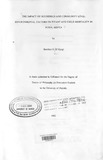| dc.description.abstract | This study attempts to determine the impact of household and community level
environmental factors on infant and child mortality in rural Kenya. A broader definition
of environment is used in this study to include the physical conditions that affect the child
in the household (such as quality of household water, sanitation and housing) and in the
community (such as malaria prevalence, type of treatment commonly provided to sick
children, levels of protection against diseases by way of immunization, breastfeeding and
nutrition). The broad study hypothesis derived from the literature reviewed is that both
household and community levels environmental factors have significant impact on infant
and child mortality. The specific study hypotheses were formulated and tested being
guided by the analytical structure derived from Mosley and Chen (1984) conceptual
framework for studying child survival in developing countries but with a slight
modification to cater for incorporation of the community level contextual factors.
The formulated study hypotheses were tested using the dependent variable defined
as the risk of death for children aged under five years segmented into six age intervals
to cater for differentials in infant and child mortality pattern by age. In order to control
for the effects of other factors that affect infant and child mortality not classified in this
study as environmental, other groups of factors classified as maternal proximate variables
and socio-economic variables were included in the analysis as the independent variables
in addition to the environmental variables. Proportional hazards regression in log-linear
format was used in this study as the main method of data analysis although other methods
such as life table analysis were also used to study the differentials in infant and child
mortality by categories of the environmental and other variables included in the study.
The 1989 Kenya Demographic and Health Survey data restricted to 5826 children born
since January 1st, 1983 by the ever married women respondents in the survey and living
in 326 rural clusters served as the basic data set. The community level environmental
variables were computed from 6220 children born to ever and never married women in
these 326 clusters. Data on 3444 children aged 5 to 60 months in the 326 rural clusters
gathered in the 1987 Rural Nutrition Survey were used to compute community level
nutrition variables. Overall, the data were assessed and found to be of good quality.
At the household level, the results of the bivariate analysis established that better
toilet facility, better quality of housing floor, and less contaminated water have
statistically significant negative association with the risk of infant and child mortality.
The study data reject the study hypothesis regarding the association between household
crowding and infant and child mortality. After controlling for other factors in the full
multivariate model used, better quality of housing floor was found to have a statistically
significant protective effect at 99% confidence level. Children in households with modern
floor quality have mortality risks estimated at about 61% lower relative to those in the
worse-off category. Better toilet facility has a protective effect on risk of infant and child
death although it is not statistically significant after controlling for other factors.
At the community level, the results of the bivariate analysis established that
communities where malaria is not endemic, where mean breastfeeding durations exceed
15 months, and where immunization coverage exceed 67% have statistically significant
negative association with the risk of infant and child death. Communities with mean
estimate of children in normal nutrition category of over 61% have statistically
insignificant negative association with the risk of infant and child death. The study data
reject the hypothesized association between risk of infant and child death with the type
of medical care provided to the sick children in the community. The multivariate analysis
results established that where malaria is endemic and where breastfeeding durations are
15 months or shorter, infant and child mortality rates are statistically significantly higher
(at 99% confidence level) even after controlling for the other factors. Infant and child
mortality risks in malaria non endemic communities are 37% lower relative to malaria
endemic communities. Children in communities with mean breastfeeding durations of
over 15 months have mortality risks about 69% lower relative to those in communities
with 15 months and under. The study data also established that the nutrition factor has
insignificant impact once other factors are controlled for.
The study has also important findings on the impact of other factors included in
the analysis as control variables. For instance, at the current levels of infant and child
mortality in rural Kenya, maternal education of under 9 years has insignificant protective
effect on infant and child mortality; polygamous marriage unions have significant
negative impact; proximate factors' such as non prime reproductive maternal ages at
child's birth, first and six plus parities, multiple births and preceding birth intervals of
under 24 months have higher levels of infant and child mortality.
The findings of this study have a number of implications for policy and for
further research. The study shows that there is need to re-orient housing policy in rural
areas towards improving household. dwelling units; need to intensify malaria control,
prevention and treatment programmes; and need to intensify breastfeeding promotion,
population information education and communication, and family planning programmes
in rural Kenya. The results of the study call for further research to establish the
mechanism through which malaria and breastfeeding factors act to affect significantly
infant and child mortality; and the mechanism through which polygamous marriage
unions act to affect adversely the risk of infant and child death in rural Kenya. The
results of this analysis also show the need for sharpening future survey instruments to
improve the quality of information to be gathered on morbidity of children, occupation
of parents, and other wealth related factors at both household and community levels to
enhance analysis of infant and child mortality | en |

